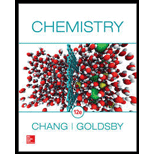
Interpretation:
The number of protons, neutrons and electrons in given species has to be identified.
Concept Introduction:
Mass number(A): Mass number of an element is sum of protons and neutrons of the atom.
Consider an element X with
Where, A is mass number and Z is atomic number (number of proton or electron)
Answer to Problem 2.15QP
Number of proton, neutron and electrons for given species are given as follows.
| Isotopes | |||||||
| No. of Protons | 2 | 2 | 12 | 12 | 22 | 35 | 78 |
| No. of Neutrons | 1 | 2 | 12 | 13 | 26 | 44 | 117 |
Explanation of Solution
For
Thus, the number of neutrons, protons and electrons are found as
For
Thus, the number of neutrons, protons and electrons are found as
For
Thus, the number of neutrons, protons and electrons are found as
For
Thus, the number of neutrons, protons and electrons are found as
For
Thus, the number of neutrons, protons and electrons are found as
For
Thus, the number of neutrons, protons and electrons are found as
For
Thus, the number of neutrons, protons and electrons are found as
The number of protons, neutrons and electrons in given species were identified.
Want to see more full solutions like this?
Chapter 2 Solutions
Chemistry
- 1. E/Z and Chirality.. (a) ) Assign the priorities (as either high and low, or 1 and 2) for the four groups of the alkene. Based on those assigned priorities, predict the configuration (E or Z). Include the corresponding priority directly adjacent to each of the four groups. H3C H3C ॐ HO CH3 _) Assign each of the following molecules as chiral or achiral. (b). (i) HO (ii) Н E OH H₂CCH₂ Н H3C H Br Br H CH3 2. E2 Mechanism and Products Draw an arrow pushing mechanism for the elimination reaction below and draw all products formed (including all organic and inorganic products). H CH2 O=S. HII. CH3 H 'H H3C CH3arrow_forwardPlease correct answer and don't used hand raitingarrow_forwardBriefly comment on the structure of a natural clay. Indicate the similarities and differences between natural clays and pillared clays.arrow_forward
- State what clays are. Briefly state the differences between natural, exchanged and pillared clays.arrow_forwardExplain and differentiate between stacked and pillared structures.arrow_forwardIn montmorillonite C, the more interlayer water penetrates,a) the lower the cation-sheet attractionb) the greater the interlayer attractionc) the dipole of the water molecule compensates for the cation defectd) the more the interlayer anions are exchangedarrow_forward
- Indicate whether graphite oxide conducts electricity in sheets.arrow_forwardThe vapor pressure of ethanol (C2H5OH) at 40.85°C is 0.176 atm; at 69.85°C, it is 0.682 atm. (a) Calculate the molar enthalpy of vaporization (AHvap) of ethanol. AHvap = kJ mol-1 (b) Calculate the normal boiling point of ethanol. Normal boiling point = °Carrow_forwardNonearrow_forward
 Chemistry & Chemical ReactivityChemistryISBN:9781337399074Author:John C. Kotz, Paul M. Treichel, John Townsend, David TreichelPublisher:Cengage Learning
Chemistry & Chemical ReactivityChemistryISBN:9781337399074Author:John C. Kotz, Paul M. Treichel, John Townsend, David TreichelPublisher:Cengage Learning Chemistry & Chemical ReactivityChemistryISBN:9781133949640Author:John C. Kotz, Paul M. Treichel, John Townsend, David TreichelPublisher:Cengage Learning
Chemistry & Chemical ReactivityChemistryISBN:9781133949640Author:John C. Kotz, Paul M. Treichel, John Townsend, David TreichelPublisher:Cengage Learning Chemistry: Principles and PracticeChemistryISBN:9780534420123Author:Daniel L. Reger, Scott R. Goode, David W. Ball, Edward MercerPublisher:Cengage Learning
Chemistry: Principles and PracticeChemistryISBN:9780534420123Author:Daniel L. Reger, Scott R. Goode, David W. Ball, Edward MercerPublisher:Cengage Learning General Chemistry - Standalone book (MindTap Cour...ChemistryISBN:9781305580343Author:Steven D. Gammon, Ebbing, Darrell Ebbing, Steven D., Darrell; Gammon, Darrell Ebbing; Steven D. Gammon, Darrell D.; Gammon, Ebbing; Steven D. Gammon; DarrellPublisher:Cengage Learning
General Chemistry - Standalone book (MindTap Cour...ChemistryISBN:9781305580343Author:Steven D. Gammon, Ebbing, Darrell Ebbing, Steven D., Darrell; Gammon, Darrell Ebbing; Steven D. Gammon, Darrell D.; Gammon, Ebbing; Steven D. Gammon; DarrellPublisher:Cengage Learning Chemistry for Today: General, Organic, and Bioche...ChemistryISBN:9781305960060Author:Spencer L. Seager, Michael R. Slabaugh, Maren S. HansenPublisher:Cengage Learning
Chemistry for Today: General, Organic, and Bioche...ChemistryISBN:9781305960060Author:Spencer L. Seager, Michael R. Slabaugh, Maren S. HansenPublisher:Cengage Learning





